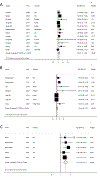Inflammation markers and risk of developing hypertension: a meta-analysis of cohort studies
- PMID: 30700522
- PMCID: PMC6588169
- DOI: 10.1136/heartjnl-2018-314216
Inflammation markers and risk of developing hypertension: a meta-analysis of cohort studies
Abstract
Objective: To systematically assess the association of circulating inflammation markers with the future risk of hypertension.
Methods: We did a systematic literature search of PubMed and Scopus, from database inception to July 10, 2018. Prospective and retrospective cohort studies evaluating the association of circulating C reactive protein (CRP), high-sensitive CRP (hs-CRP), interleukin 6 (IL-6) and IL-1β to the risk of developing hypertension in the general population were included. The relative risks (RRs) for the top versus bottom tertiles of circulating biomarkers were calculated using a fixed-effects/random-effects model. A potential non-linear dose-response association was tested.
Results: Fourteen prospective cohort studies, two retrospective cohort studies and five nested case-control studies involving 142 640 participants and 20 676 cases were identified. The RR for the third versus first tertiles of circulating CRP was 1.23 (95% CI 1.11 to 1.35; I2=59%, n=12). The association remained unchanged after adjustment for body mass index. The RRs for other biomarkers were as follows: hs-CRP (RR 1.20, 95% CI 1.02 to 1.37; I2=74%, n=7), IL-6 (RR 1.51, 95% CI 1.30 to 1.71; I2=0%, n=5), and IL-1β (RR 1.22, 95% CI 0.92 to 1.51; I2=0%, n=3). A non-linear dose-response meta-analysis demonstrated that the risk of hypertension increased linearly with increasing circulating inflammation markers, even within the low-risk and intermediate-risk categories.
Conclusions: Higher levels of circulating CRP, hs-CRP and IL-6, but not IL-1β, were associated with the risk of developing hypertension. The association persisted in subgroups of studies defined by major sources of heterogeneity.
Keywords: hypertension; inflammatory markers; meta-analysis.
© Author(s) (or their employer(s)) 2019. No commercial re-use. See rights and permissions. Published by BMJ.
Conflict of interest statement
Competing interests: None declared.
Figures


Comment in
-
Should inflammatory pathways be targeted for the prevention and treatment of hypertension?Heart. 2019 May;105(9):665-667. doi: 10.1136/heartjnl-2018-314625. Epub 2019 Jan 30. Heart. 2019. PMID: 30700517 No abstract available.
Similar articles
-
Salivary inflammatory markers in tension type headache and migraine: the SalHead cohort study.Neurol Sci. 2020 Apr;41(4):877-884. doi: 10.1007/s10072-019-04151-4. Epub 2019 Dec 10. Neurol Sci. 2020. PMID: 31823093 Clinical Trial.
-
Inflammatory Markers of CRP, IL6, TNFα, and Soluble TNFR2 and the Risk of Ovarian Cancer: A Meta-analysis of Prospective Studies.Cancer Epidemiol Biomarkers Prev. 2016 Aug;25(8):1231-9. doi: 10.1158/1055-9965.EPI-16-0120. Epub 2016 Jun 8. Cancer Epidemiol Biomarkers Prev. 2016. PMID: 27277846
-
Cytokines and hs-CRP levels in individuals treated with low-dose aspirin for cardiovascular prevention: a population-based study (CoLaus Study).Cytokine. 2014 Apr;66(2):95-100. doi: 10.1016/j.cyto.2014.01.003. Epub 2014 Feb 3. Cytokine. 2014. PMID: 24594292
-
C-reactive protein and fracture risk: an updated systematic review and meta-analysis of cohort studies through the use of both frequentist and Bayesian approaches.Osteoporos Int. 2021 Mar;32(3):425-435. doi: 10.1007/s00198-020-05623-6. Epub 2020 Sep 15. Osteoporos Int. 2021. PMID: 32935169
-
Circulating cytokines and risk of developing hypertension: A systematic review and meta-analysis.Pharmacol Res. 2024 Feb;200:107050. doi: 10.1016/j.phrs.2023.107050. Epub 2023 Dec 29. Pharmacol Res. 2024. PMID: 38159784
Cited by
-
Dietary Inflammatory Index and All-Cause Mortality in Older Adults with Hypertension: Results from NHANES.J Clin Med. 2023 Jan 7;12(2):506. doi: 10.3390/jcm12020506. J Clin Med. 2023. PMID: 36675436 Free PMC article.
-
Impact of Intermittent Hypoxia Related to Obstructive Sleep Apnoea Syndrome on Low-Grade Inflammation in Hypertensive Patients: Potential Implications for Cardiovascular Risk.Life (Basel). 2024 May 6;14(5):592. doi: 10.3390/life14050592. Life (Basel). 2024. PMID: 38792613 Free PMC article.
-
Monocyte-to-Neutrophil Ratio as an Immunological Marker of Left Ventricular Hypertrophy in Children with Primary Hypertension.J Clin Med. 2025 Jun 1;14(11):3896. doi: 10.3390/jcm14113896. J Clin Med. 2025. PMID: 40507658 Free PMC article.
-
Association between inflammatory biomarkers and hypertension among sedentary adults in US: NHANES 2009-2018.J Clin Hypertens (Greenwich). 2024 Aug;26(8):945-954. doi: 10.1111/jch.14851. Epub 2024 Jun 30. J Clin Hypertens (Greenwich). 2024. PMID: 38946147 Free PMC article.
-
Inflammageing and Cardiovascular System: Focus on Cardiokines and Cardiac-Specific Biomarkers.Int J Mol Sci. 2023 Jan 3;24(1):844. doi: 10.3390/ijms24010844. Int J Mol Sci. 2023. PMID: 36614282 Free PMC article. Review.
References
-
- Kearney PM, Whelton M, Reynolds K, et al. Global burden of hypertension: analysis of worldwide data. Lancet 2005;365:217–23. - PubMed
-
- Chow CK, Teo KK, Rangarajan S, et al. Prevalence, awareness, treatment, and control of hypertension in rural and urban communities in high-, middle-, and low-income countries. JAMA 2013;310:959–68. - PubMed
-
- Bautista LE, López-Jaramillo P, Vera LM, et al. Is C-reactive protein an independent risk factor for essential hypertension? J Hypertens 2001;19:857–61. - PubMed
-
- Bautista LE, Vera LM, Arenas IA, et al. Independent association between inflammatory markers (C-reactive protein, interleukin-6, and TNF-alpha) and essential hypertension. J Hum Hypertens 2005;19:149–54. - PubMed
Publication types
MeSH terms
Substances
Grants and funding
LinkOut - more resources
Full Text Sources
Medical
Research Materials
Miscellaneous
